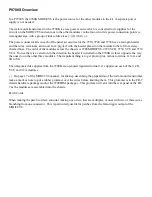
© 2014 CPT Autopilot Inc.
www.cptautopilot.com
Page 13 of 17
.
2. Connector Maintenance
Connectors for the power cable, if installed, should be maintained with corrosion inhibitor, silicone grease,
vaseline, T-9, or silicone sprayed into both plug and socket ends each season. Caps should be in place and tight if
plugs are not fitted. Connectors are a liability if not maintained & kept greased, & the cable jacket should be kept
sealed and not open or exposed.
The CPT cables are not removable
. The black cable fittings on sensor and drive box are not plugs, do not
loosen them. Attempting to remove them will damage components and void the warranty. The sensor and
power cables are soldered directly to circuit boards inside the boxes. After sea trials the sensor cable can be
cut and spliced for routing or connected to a terminal block below deck. The cable is color coded and
shielded, and the shield must be kept continuous by splicing aluminum or copper foil and placing around the
splice.
3. Storage
After use, lightly spray with fresh water and lightly wipe the CPT down with a cloth and dry it. Do not use
alcohol or solvents to clean the drive or sensor, they may remove the paint & graphics. Store the unit in a dry
place when not in use, or protect it with a wheel/binnacle cover or other appropriate cover. When the boat is laid
up, take the pilot home if possible. Do not store it in a damp locker during lay-up, or a location subject to
flooding or damp conditions.
When stored, store sensor and drive boxes on their sides, with the control
knobs facing & clutch facing sideways, not facing up or down.
WARNING!
Do not store the CPT in the bilge or any locker liable to flooding, leaking, or standing water.
(
See technical
specifications)
4. Wheel Pulley
If preferred, wax the wheel pulley to maintain gloss. After a season, check to make sure the wheel is still
centered on the steering wheel and adjust if needed. Do not over-tighten J-bolts (See “Installing Wheel Pulley”)
or the pulley will distort over time.
5. Factory Service
It is recommended that the CPT be returned to the factory to have the watertight seals replaced every 10 years
depending on weather exposure and amount of use. This is also worthwhile if it has been used for many years
and you are planning an extensive passage. There is a nominal charge, but if the seals become worn or brittle and
salt water enters the unit, repairs may be extensive. The drive & sensor should be securely bubble-wrapped with
½” bubble-wrap, then separated by cardboard & boxed, and boxed again with 1” of peanuts when shipping.
6. Troubleshooting
Specialized equipment is required to service the CPT, there is no internal fuse or other internal parts that are
owner-serviceable. For satisfactory and warranted repairs, repairs should be done only by the factory.
UNAUTHORIZED REPAIR ATTEMPTS VOID THE WARRANTY REGARDLESS OF
CIRCUMSTANCES
Does Not Steer In Either Direction
Be sure shear pins are not damaged and that clutch is engaged. Test that CPT has a good 12-volt power
connection, no oxidized connections. Check battery voltage (12.5 volts minimum), check voltage at
power cable connection
as
pilot motor runs (set to tack & turn rudder to 10)
;
voltage drop when
the motor runs means poor connections and/or inadequate wire size
. Trace back the power supply
for breakage, loose/oxidized connections, a blown fuse, defective fuse holder, etc. Poor connections,
switches, and small gauge wires can cause voltage drop, blown fuses and damaged circuits. The pilot
will compensate for voltage drop by drawing more current. With the belt off and clutch engaged, turn




































